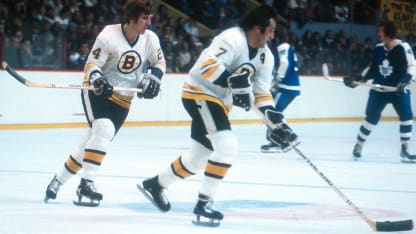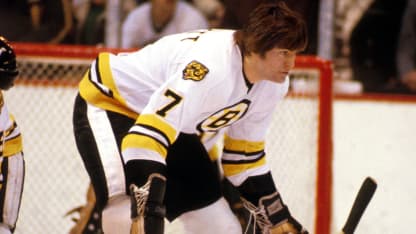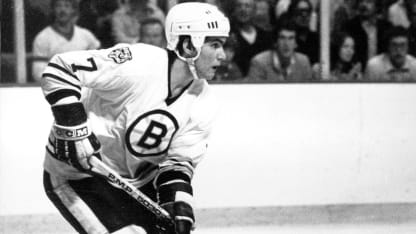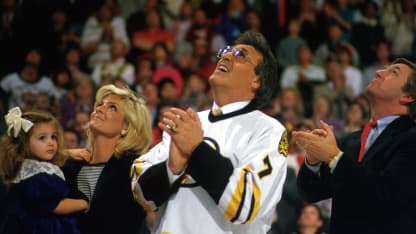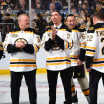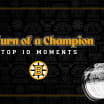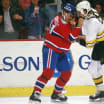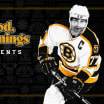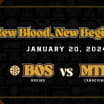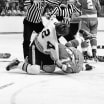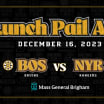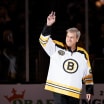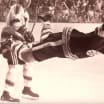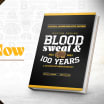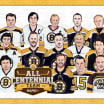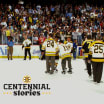That moment finally came on Dec. 3, 1987 – six years after Esposito’s retirement from the NHL – when the Bruins hosted the New York Rangers at Boston Garden.
Sinden: “He went to the Rangers, he was no longer a Bruin. But when he retired, he returned to being a Bruin as far as we were concerned and as far as the Garden fans were concerned. That was the apt time to do it. You couldn’t do it while he was wearing a Rangers jersey. We had to wait until he retired which we did.”
Esposito: “I remember when Harry called me and he said, ‘Listen, we’re gonna retire your number, put it up there, and when Bourquey retires, we’re gonna put his name too.’ I said, ‘No problem, that’s great.' Why not? Raymond is one of the good guys and one of the top players in the league.’’
Esposito, then New York’s general manager, was slightly hesitant, however, to have his number retired on a night when the Rangers were in town.
Esposito: “I remember asking Harry, ‘can we not do it on a night that the Rangers are in town?’ I had just gotten the general manager’s job that I really didn’t want, but they made me an offer I couldn’t refuse. Either work as a GM or don’t work for Madison Square Garden, so you take the job.
“But I didn’t want it [against the Rangers] because I had mixed emotions, big-time mixed emotions. [If] we lost, the Bruins beat us, how the hell am I going to celebrate? If we won, I still really didn’t feel like celebrating because I was still a Boston Bruin in my mind. I still am. I still consider that.”
The Bruins had a strong plan in place for the program, but there was one very awkward situation remaining – the number was still in circulation with Bourque, who by that time was already on his way to a Hall of Fame career, donning No. 7.
The night before the ceremony, the Bruins were in Hartford for a 5-3 win over the Whalers. Sinden, Tom Johnson, and Greenberg made the late-night drive back to Boston separate from the team and came up with a plan during the car ride: during the ceremony, Bourque would surprise Esposito – and the hockey world – by switching to No. 77.
Greenberg: “Truth be known, Harry and I and Tom Johnson were driving back from Hartford after one of the Bruins’ games and basically kicked it around in the car…it was really a spur of the moment thing.”
Sinden: “We were coming back from a game and we were thinking about the jersey number to be retired and that Ray was wearing it and that it was kind of awkward. I came up with the idea that we retire 7 and give Ray 77…we thought that would be an ideal way to cover an awkward situation.”
The next step was getting Bourque’s approval. Naturally, that part was not an issue.
Sinden: “I said, ‘I’ll call Ray and make sure he’s OK with that because it’s his number.’ Which I did. Ray was all for it, whatever we wanted to do. He was a very cooperative player.”
Greenberg: “Harry [called]…I think I heard the conversation. I don’t remember exactly. [Bourque] needed a nanosecond to go along with it. He’s a terrific guy. There wasn’t the slightest bit of hesitation to agree with it. We told him what we were gonna do, is have both jerseys on and just take the other one off and give it to Phil. Once the idea was hatched, it didn’t take very long. You want Bourque’s blessing and we got it without any hesitation whatsoever.”
Bourque remembers the call coming from Sinden and O’Reilly, who was then the Bruins’ head coach, the day of the game.
Bourque: “It took them a while to decide to retire the number and they decided to retire it December 3, 1987, and nothing was ever said what was gonna happen with the number until I got a call from [Sinden and O'Reilly, who said], ‘we got to talking about what we we’re gonna do with the number and we came up with the idea,’ that I was gonna go out for warmups with No. 7 and come in after warmup, go in the trainers’ room, go in the back, and put No. 77 underneath and go out and call Phil up and reveal No. 77.”
Once Bourque gave his blessing, Sinden had to scramble to let the equipment managers – Larry Ness and the late Bobby Crocker – know so a new No. 77 jersey could be made.
Crocker called Rick Cavallaro from Custom Crafted Sports, the North Attleboro, Mass., company that began lettering and stitching the Bruins’ jerseys just that season – and still does to this day.
Cavallaro: “My contact was Bobby Crocker. He contacted me and said, ‘We need a No. 77 for Ray, we’re gonna have a number change.’ I’m like, ‘Oh, OK.’ He did ask me not to say anything. I’m like, ‘OK, that’s fine - I understand my role, I can’t leak anything…you tell me I can’t say anything, nothing’s said.’ Of course, back then I didn’t know anybody anyways, so it didn’t even matter.”
Cavallaro, who had no idea what the number change was about or why it was happening, personally stitched the new Bourque jersey himself and then made the drive up to Boston and hand delivered the jersey to Crocker.
Cavallaro: “I did the jersey personally just so no one else saw it. I just did it. I threw it in the box and made sure I taped it because I wasn’t sure if I was gonna give it to someone else who was gonna walk it to Bobby or if I was gonna give it to him directly…
“I drove it in. Those were the days I would drive it right into the Garden and Bobby was standing right on Causeway Street…I had it in a box and I just handed it to him. He said, ‘thanks’ and he went back in and that was it. It was very quiet.
“[Crocker] was standing there in his Cliff Engle sweater, the sweaters that were popular at the time – white, black, with gold striping and Bruins.
“I like everybody else saw what they [ended up doing] on TV.”
The only other person who was let in on the plan? Bruins radio broadcaster Bob Wilson, who was set to emcee the proceedings.
Greenberg: “I alternated between Fred Cusick and Bob Wilson [for ceremonies]…this was Wilson’s turn to handle the public address and host the event. I told him that afternoon. We were hoping we could keep it under wraps.”
Somehow, some way, the plan remained a secret – from what the people interviewed for this story can recall, the only people who knew exactly what was going to happen during the ceremony were Sinden, Johnson, Greenberg, Bourque and his wife Christiane, O’Reilly, Crocker, Ness, and Wilson.
Greenberg: “The reason we were able to keep it quiet is because we didn’t come up with the idea until [the day] before…there were literally a handful of people who knew. In those days, we didn’t have social media. The plan was to try and make it a surprise for him.”
Sinden: “There wasn’t much time between the idea and the game...I don’t think I really told anybody until the next day when we did retire it…it was pretty easy to keep it secret.”
O’Reilly: “I knew…I managed to keep my mouth shut until it happened.”
Bourque: “If it would’ve been days and weeks, I think it would’ve been tougher. But no, it was just six hours that I had to hang on to that secret and it was pretty easy. I was excited about nobody knowing and kind of revealing it and really making a big splash.
“It was really, really weird and strange, the lack of communication…I drove in with Glen Wesley and Keith Crowder that night and I didn’t say a word. The only people that knew was my wife and I and the trainers and management.”
Before the ceremony, Bourque retreated to the training room to put the No. 77 jersey on underneath his No. 7.
Bourque: “I put 7 on when I was getting dressed and I just went in the back room, the trainers’ room, and just made sure. The trainers knew so I took the [No.7] sweater off and put No. 77 on underneath and then put the other one [back] on and nobody noticed nothing or saw nothing. It was pretty funny when you think about it.”
When the moment finally arrived, Wilson introduced Bourque, saying, “Ray Bourque, the captain of the Bruins, will make a presentation.” And what a presentation it was.
Bourque skated over to Esposito, shook his hand, and handed him an ‘Esposito’ Bruins jersey. As he did that, Bourque pulled off his No. 7 sweater and slowly turned around to unveil his new No. 77. Bobby Orr and O’Reilly can be seen smiling and clapping on the carpet behind them as the Bruins’ bench and the Boston Garden crowd erupts. Bourque and Esposito embraced with a hug.
Esposito: “When Bourquey took the jersey off, I looked at him – and if you could read the lips, I said, ‘what the frick are you doing?’ He said, ‘this is yours, big fellow, and it always should’ve been yours and nobody else’s.’ Well, I was stomped for words. And he did say that by the way. And I was. It was a special moment for me and my family.
“I could tell some of the Rangers brass, some of the reporters, they were a little bit, you know, this shouldn’t be happening with the Rangers playing here. That’s the only thing I had against it, but beggars can’t be choosers.”


